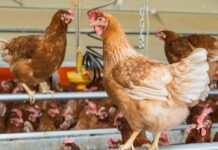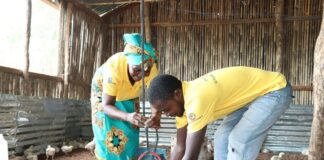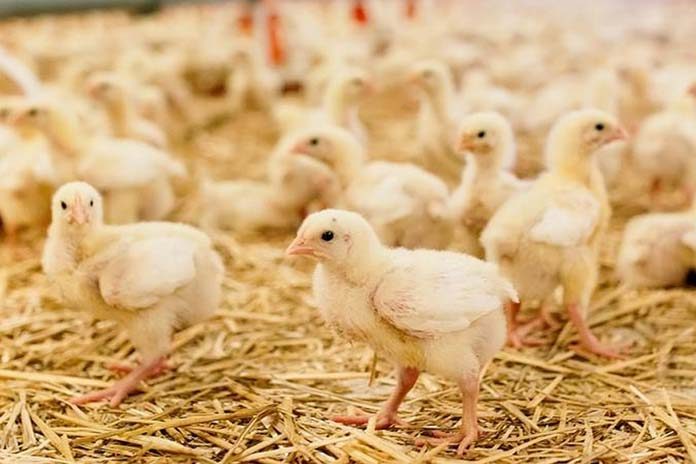
Wet litter in meat chicken sheds occurs as the result of multiple, interrelated causes. This paper discusses some of the sources of water in meat chicken sheds, the properties of litter and the contribution of the shed micro-environment.
By increasing awareness of the factors associated with wet litter, it will empower the chicken meat industry with knowledge to identify causes and address local incidences through improved litter management. In general, wet litter will be caused by excess water going into the litter, insufficient evaporation and/or limited water holding capability of the litter. Some strategies to improve the effectiveness of ventilation to maintain litter dryness are discussed.
A variety of litter management practices are used in chicken meat production due to environmental, economic, engineering and animal husbandry constraints. Litter moisture is associated with a multitude of factors such as shed micro-environment and properties of poultry litter. The term wet litter is used when the accumulation of water changes the properties of the litter in ways that are considered to be detrimental to health and welfare of the birds, production efficiency, food safety and/or the environment due to odour and ammonia production.
There is no precise, all-inclusive definition of wet litter. Lister (2009) summarised requirements in the United Kingdom that “all chickens shall have permanent access to litter which is dry and friable on the surface” but then “litter should be inspected to ensure it does not become excessively wet or dry”. Presumably, friable litter is required so that it is possible for birds to peck and scratch, but litter shouldn’t be too dry in order to control dust concentrations. But exactly how much water can litter contain before it is becomes a concern? Collett (2012) suggested that 25% moisture content (mass of water divided by mass of moist, in situ litter) is the limit above which the “cushioning, insulating and water holding capacity is compromised”. Others have reported that Salmonella and E. coli could be controlled by maintaining litter moisture below 20–35%.
El-Wahab et al. (2012) reported that the critical moisture content for the onset of foot pad dermatitis (FPD) was approximately 35%. Other studies have distinguished wet vs dry litter based on appearance or litter score, and in these cases, 1.5 to 2.5 L/m²/day of water was added to litter in order to initiate conditions to produce FPD. All things considered, there is no single value of moisture content that describes the conditions that initiate the problems associated with wet litter. Additionally, the surface moisture content of litter can vary spatially within a meat chicken shed and published literature doesn’t provide guidance as to whether all or just a portion of the shed needs to be above the critical moisture content for litter moisture to become a concern.
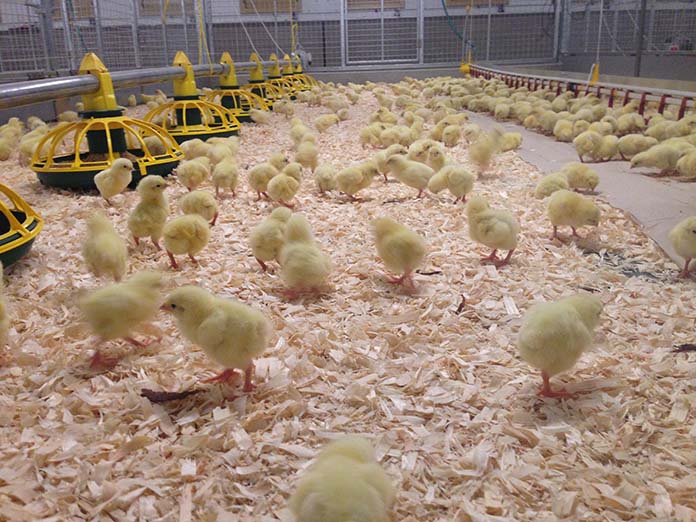
How much of the shed can have wet litter or cake and not be considered a problem?
There will be no easy resolution to litter moisture management. Wet litter is an incurable condition but the occurrence, frequency or severity of wet litter can be reduced by specific, consistent and persistent management of the litter, flock and shed micro-environment. While the intention is always to avoid wet litter, strict control of litter moisture may not always be possible due to abnormal or adverse production conditions that increase the amount of water going into the litter or that reduce evaporation.
Sources of water
There are many sources of water in meat chicken sheds that add water to the litter including excreted moisture, normal drinker spillage, leaking drinkers, shed leaks, condensation and water vapour in the air (humidity). When one or more of these are greater than normal it can contribute to the onset of wet litter.
Water in excreta is one of the primary sources of regular water addition to the litter. In the first week of a grow-out, the amount of water added to the litter is 0.5–1.2 L/m²/day. Over the course of a grow-out, the total amount of water added to the litter is over 100 L/m², which is several times more water than the litter can hold, highlighting the necessity of regular water evaporation and removal from the shed using ventilation.
These estimated amounts of water added to the litter from bird excretion are based on average conditions. When birds are out of their thermal neutral zone, if they have digestive upset, or if they are not evenly distributed in the shed, the estimated values may vary. If birds congregate at higher than average density in particular parts of the shed due to uneven conditions such as temperatures, lighting, drafts, litter condition or because of instinctive or learned behaviours (e.g. perching or migration), it can lead to wet litter commencing in localised areas within a shed. Recurrence of wet litter in the same part of a shed may be useful as a trigger to investigate the specific cause.
Drinkers are frequently identified as a cause of wet litter. Litter crusting and caking often starts underneath the drinkers, which suggests that there is higher moisture content. Water spillage underneath drinkers is unavoidable, but may be reduced with evaporation cups and by ensuring water pressure and drinker heights are optimal. Pressure needs to be sufficient for drinker nipples to seal and to ensure that water supply is adequate. Uneven pressures along drinker lines can contribute to spillage, and may be reduced with multiple supply points and specialised regulators. The height of drinkers is equally important and needs to be adjusted at least daily to ensure the birds’ beaks are positioned to minimise spillage.
Litter proprieties
Wet litter is not only about moisture, but is also about friability if the definitions provided in welfare guidelines are considered. It is therefore necessary to keep litter in a friable condition. Maintaining friability also has certain advantages apart from welfare considerations. When litter is friable, it helps to keep litter dry and enables birds to work the litter when they walk, scratch, dust-bathe and forage. This action incorporates fresh excreta, aerates the litter and regularly exchanges the litter particles at the surface where evaporation potential is greatest.
Litter moisture affects the amount of cohesion (stickiness) between litter particles, which affects friability. As litter moisture increases above 20–30%, litter particles begin sticking together and form agglomerates or clumps because water acts as a natural binder. Bernhart et al. (2010) also found that more force was required to break down the clumps and return the litter to a friable state when litter had higher moisture content at the time of compaction.
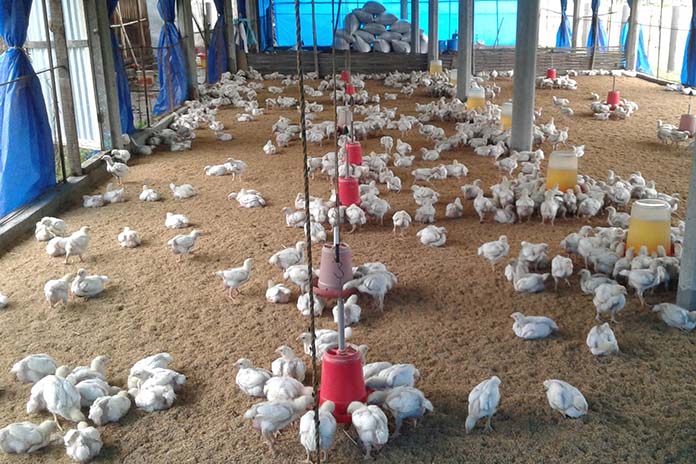
Litter dryness and friability affects the way that fresh excreta are worked into the surface of litter. When a dropping is deposited onto dry and friable litter it gets coated with litter particles. These absorb some moisture from the excreta and provide a non-sticky layer that prevents droppings from sticking together. Bird activity moves and rolls droppings over the litter surface and breaks them into smaller pieces, each becoming coated as this physical breakdown continues. This increases surface area, which accelerates moisture loss and drying, and also sustains a material that the birds can continue to work with normal activity. Conversely, when a dropping is deposited on wet or caked litter, it is unable to be coated by litter particles. The dropping becomes smeared on the litter or caked surface. Because moisture is not readily transferred to the litter below, there is sole reliance on evaporative removal from the litter surface and the dropping will stay wetter for longer. When conditions in the shed don’t favour drying (e.g. low air velocity and high humidity, which frequently occur at night) the damp manure layer grows. Because it forms at high moisture content, the energy/force required to break the manure down into a friable mixture is more than the birds can manage.
There is a need to focus on conditions at the litter surface in order to understand and address wet litter. Water is routinely applied at the surface from drinker spillage, excreta and absorption of humidity from the air. Water is also evaporated from the litter surface. If the surface is damp, manure crusting and/or caking occurs, which slows the rate of drying from the litter surface and slows the movement of water into the litter below the caked surface.
Moisture at the litter surface is an important consideration and yet it is rarely specifically measured; instead the average moisture of the full litter depth is most often measured. The value of this is questionable because a few hours (e.g. overnight) of high humidity or water application may be sufficient for the surface to act like wet litter even though the average moisture content for the full litter depth might suggest that the litter is fairly dry. Measuring litter surface conditions in a meaningful and repeatable manner is something that requires further investigation and development.
Water storage capability of litter
“So how much water is in litter?” This is a very important question and there are several ways to measure the wetness of litter; however, none of these necessarily help with establishing the critical point at which litter could be defined as wet. This is because not all litter materials behave the same, especially with respect to stickiness, matting and friability. The properties of litter also change during a grow-out, so while bedding/litter may behave in a certain way at the start of a grow-out, it may behave differently at the end.
The most common way to measure the wetness of litter is with the unit moisture content, which is calculated by dividing the mass of water contained in the litter by the mass of the litter, expressed as a percentage. For example, if a sample of litter has 25% moisture content, then a quarter of the mass of the litter is water. One shortcoming with this unit of measurement is that the density (mass divided by volume) of the dry litter material affects the calculation of moisture content. The denser a material, the more water it will contain for the same value of moisture content. This requires careful consideration when trials are conducted with different bedding/litter materials, or those that contain different amounts of manure.
An alternative method to measure the wetness of litter is to consider the actual volume of water contained in a square metre of litter (litres per square metre, L/m²) assuming a specified depth (e.g. 5 cm). By using this measure, it is possible to calculate a water balance if water inputs and evaporation are known. This method of describing litter wetness also has its limitations, especially in defining the volume of the litter material, which can be difficult because litter is readily compressible.
Water activity is important in three processes that occur within litter:
- microbiological growth;
- litter stickiness/friability and
- water absorption and evaporation.
Microbiota require a certain amount of water to grow, and the availability of this water is related to water activity. Thus maintaining relatively dry litter (below 20–25% moisture content depending on specific litter properties) is sufficient to reduce the growth of specific organisms. It is suggested that relatively higher water activity early in the grow-out (when using fresh bedding) may increase microbiological risks.
Stickiness and friability are directly related to water activity because water needs to be available on the surface of particles to form inter-particle bonds. Once litter reaches a critical hydration level, particle surfaces plasticise and merge with neighbouring particles which results in compacted clumps rather than a friable material. Bernhart and Fasina (2009) found that reduction in friability occurred at a water activity of approximately 0.80-0.85 (corresponding to moisture content 18-22%).
Shed microenvironment
Water absorption/evaporation between the litter and air is related to the relationship between water activity of the litter and relative humidity of the air (i.e. a water activity gradient). Water will travel from a condition of high water activity to low water activity, and this becomes the driving force to move water within litter and between the litter and air. The rate at which water will move through the litter is also controlled by the molecular diffusion of water through the pores. Because of this, the movement of water through litter will be slower if pores are long or constricted (i.e. litter is compacted or composed of fine materials). Also, movement of water from the base of a thick bed of litter will be much slower than from the surface. Consequently, if litter is deep and allowed to become wet all the way to the base, it will be slow to dry.
Recalling that the other name for water activity is equilibrium relative humidity, the transfer of water will be regulated by the water activity of the litter and the relative humidity of the air. If the water activity is lower in the litter than the relative humidity of the air, then the litter will absorb moisture from the air but if the situation is reversed then water will transfer from the litter to the air. Therefore, one way to ensure that water is evaporating from litter into the air is to ensure that the relative humidity of the air at the litter surface is kept as low as possible.
Relative humidity of the air at the litter surface can be controlled with temperature regulation. As a general rule, the relative humidity of air halves if the air temperature is increased by 10–14 °C or the relative humidity doubles if the temperature drops by 10–14 °C, to a maximum of 100% at which time water condenses out of the air creating a fog of water droplets.
Payne (1967) and Weaver and Meijerhof (1991) recommended that an in-shed relative humidity of 72–75% was sufficient to cause wet litter or result in litter surface caking. Czarick and Fairchild (2012) recommended that the relative humidity should be kept below 60%.
Modern meat chicken sheds, when well designed and operated, are effective at minimising the relative humidity at the litter surface. This is achieved by having insulation to retain heat within the shed and using well-designed wall inlet vents to mix incoming air with the warm air. However, this action may be ineffective if the in-shed static pressure is not adequate, if the vents are not well adjusted or if exposed battens/purlins on the ceiling prevent air from reaching the ceiling apex and fully mixing. Maintaining warm, low relative humidity air at the litter surface may be enhanced with the use of thermal destratification fans.
Sufficient moisture-laden air needs to be exhausted from the shed to prevent in-shed relative humidity from increasing. When sheds transition into tunnel ventilation, frequent air exchange in the shed prevents the build-up of relative humidity and high air speed is effective at removing moisture from the litter; however, using evaporative cooling increases the relative humidity in the shed, which reduces litter drying. To reduce this effect, Czarick and Fairchild (2014) suggest a ventilation strategy that utilises maximum shed airspeed (at least 3.0 m/s) and not introducing evaporative cooling until the temperature reaches approximately 29 °C. Applying this strategy was found to be effective in maintaining friable litter inside the shed nearest the cool cells.

Ventilation needs to be effective at removing water. This means more than simply having enough fans operating. It means bringing in enough air and conditioning it – usually with heat – to lower its relative humidity so it can absorb more water. It is then essential to get this air to the litter where the water needs to be removed. This can be a challenge for litter located underneath drinkers or where birds congregate. For example, if the litter is damp or caked under the drinkers but dry and dusty in between, then simply increasing the number of fans may not necessarily be effective. The reasons for excess water deposition or insufficient evaporation need to be specifically investigated.
There are many interrelated factors that contribute to wet litter. There is a substantial quantity of water added to the litter from bird excretion and drinking spillage and even more is added still if there is an upset condition or if the relative humidity of the air at the litter surface is high. The capacity of litter to hold water, and to bind water tightly with low water activity, increases during a grow-out. But if ventilation is not effective, the litter surface can become damp within a short period of time (i.e. hours), which can be enough for wet litter and manure crusting/caking to occur. Effective ventilation requires incoming air to be conditioned so that it has low relative humidity (less than 60%) and can absorb moisture from the litter. Water needs to be removed from where it is being applied, which can be a challenge because water addition is not uniform across the shed floor. Strategies that regulate the relative humidity of air at the litter surface and keep the air moving, (e.g. using destratification fans and not excessively using evaporative cooling) may help to prevent wet litter from occurring.
By
Dunlop. M. W. – Department of Agriculture and Fisheries, Queensland Government, Australia; UNSW, School of Civil and Environmental Engineering, Sydney, Australia; Poultry CRC University of New England, Armidale, Australia.
Stuetz, R. M. – UNSW, School of Civil and Environmental Engineering, Sydney, Australia.
References are available on request.
Source: from the Proceeding of the Australian Poultry Science Symposium




